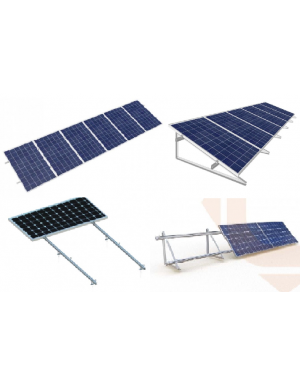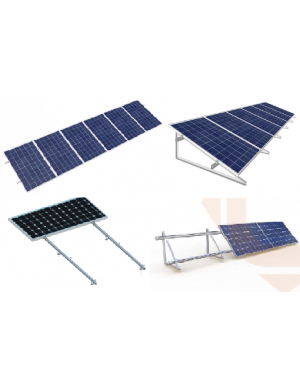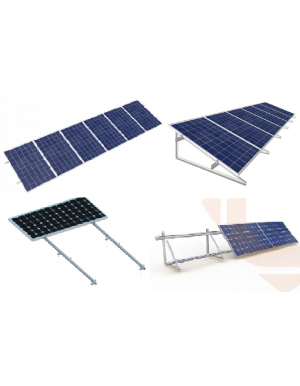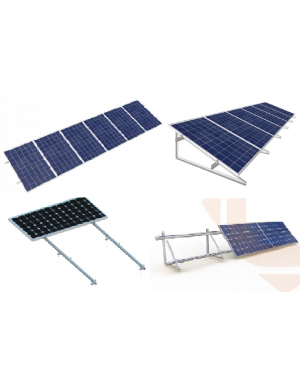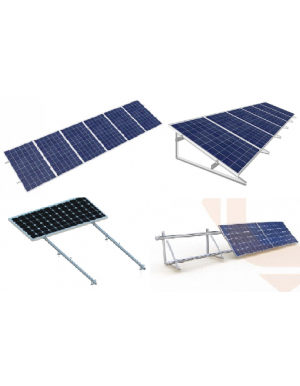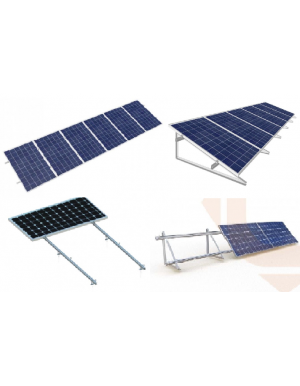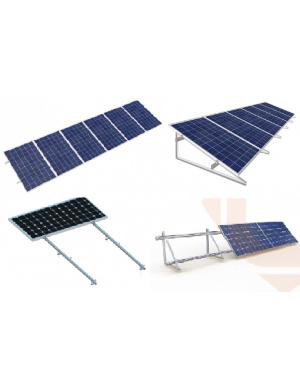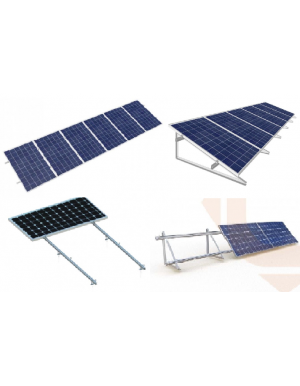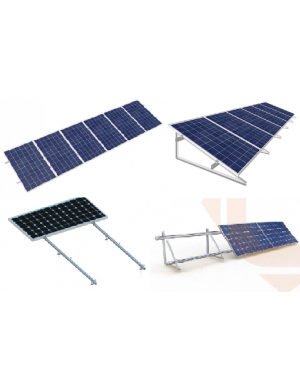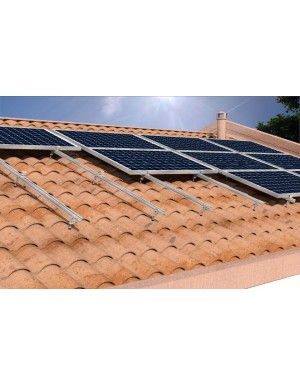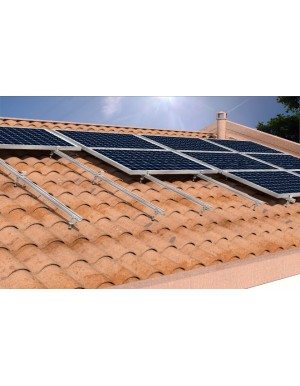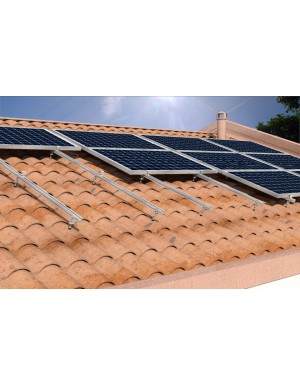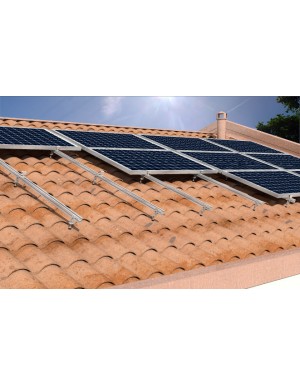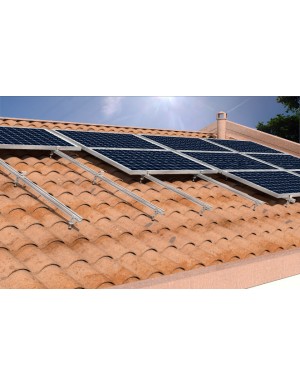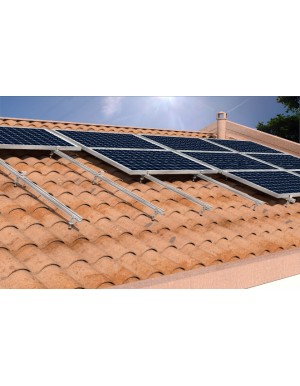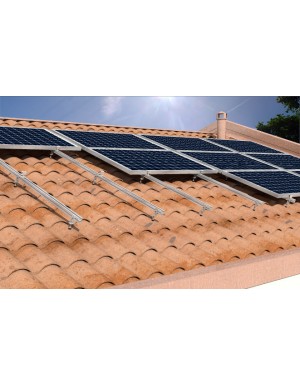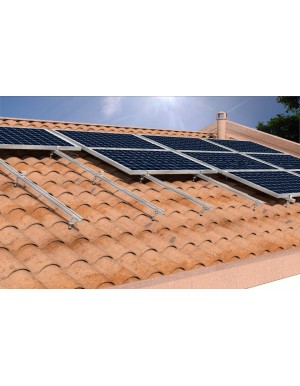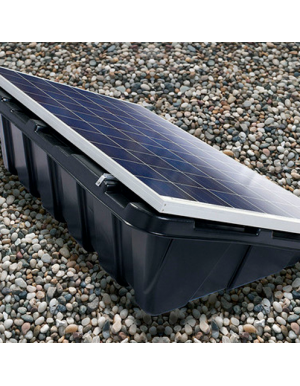Structures for solar panels
- - What types of solar panel mounts are there?
There are several types of brackets or structures used to mount solar panels, and the choice depends on factors such as location, type of installation, and specific site conditions. Here are some common types of solar panel mounts:
Pitched Roof Structures: These brackets are designed for pitched roofs, such as the roofs of houses or buildings. They can be adjustable to optimize the tilt angle of the solar panels and maximize solar energy collection.
Flat Roof Structures: For flat roofs, supports designed to tilt the solar panels at the proper angle are used. They can be fixed or adjustable and are often designed to withstand wind and weather conditions.
Solar Trackers: These are more advanced systems that allow solar panels to follow the path of the sun during the day. Solar trackers can increase the efficiency of energy collection, but they are also more complex and expensive to install and maintain.
Ground Structures: For ground installations, structures are used that raise the solar panels to a suitable height to capture solar radiation. They can be fixed systems or solar tracking systems.
Wall Structures: Solar panels can also be mounted on walls or vertical surfaces using specific brackets. This is common in commercial or residential applications where roof space is limited.
Integrated Structures: Some structures are designed to integrate solar panels into parts of the building, such as roofs or facades. This provides a more aesthetically pleasing appearance and a smoother integration with the building structure.
Floating Structures: In areas with bodies of water, such as lakes or ponds, it is possible to use floating structures to mount the solar panels. These structures allow the installation of solar systems in aquatic environments.
Parking structures: In places such as parking lots, structures can be installed that support solar panels over parking spaces, providing shade and generating energy at the same time.
The choice of structure type will depend on several factors, including the type of available area, geographic location, load-bearing capacity, local building codes, and solar system performance goals. It is advisable to consult with solar installation professionals to determine the most appropriate structure for your project.
- - What does the roof have to be like in order to install solar panels?
To install solar panels on a roof, it is important to consider certain factors related to the structure and orientation of the roof. Here are some key considerations:
Orientation and Tilt: The ideal roof for solar panel installation faces south in the northern hemisphere (or north in the southern hemisphere) to maximize sun exposure throughout the day. The optimum tilt depends on the latitude of your location, but is generally in the range of 30 to 45 degrees. However, solar panels can also work well at slightly different inclinations.
Shade: It is important that the roof is not shaded by trees, buildings, or other obstructions during peak solar radiation hours. Shading can drastically reduce the energy output of the panels.
Size and Space: The roof must have enough space available for the number of solar panels you wish to install. Solar panels come in different sizes and capacities, so it is essential to check the dimensions and make sure there is enough unobstructed space.
Condition of Structure: The roof must be in good condition and able to support the additional weight of the solar panels, as well as wind and snow loads according to local building codes.
Roof Material: Solar panels can be installed on a variety of roof types, including tile, sheet metal, flat roof and more. Mounting systems are designed to accommodate different roof types.
Roof Pitch: If the roof has a flat or steep roof pitch, specific mounting systems may be needed, such as tracking systems for flat roofs or adjustable support structures for steeply pitched roofs.
Permits and Regulations: Before installing solar panels on a roof, it is important to check if local permits or approvals are required. Some areas may have specific regulations regarding the installation of solar panels.
Remember that each installation is unique, so it is advisable to consult with a solar professional or certified installer to evaluate your roof and determine the feasibility of the installation.
- -How much weight can a solar panel support?
The weight that a solar panel can support depends on the type of panel, its size and the mounting system used. Solar panels are designed to be relatively lightweight and durable, but it is important to consider the weight when installing them on structures such as roofs or supports. Below, I provide you with a general idea of the weight of solar panels:
Conventional Photovoltaic Solar Panels - Traditional photovoltaic solar panels, which are the most common, typically weigh around 15 to 25 kilograms (33 to 55 pounds) per panel, depending on the size and power of the panel. Larger and higher capacity panels tend to be heavier.
Thin Film Solar Panels: Thin film solar panels tend to be lighter than conventional panels. They can weigh around 10 to 20 kilograms (22 to 44 pounds) per panel.
It is important to remember that the total weight of the solar system also includes the rails, brackets and other components of the mounting system. Therefore, when calculating the total weight, you must consider not only the weight of the solar panels but also the weight of all additional components that will be used to mount the panels on the roof or other structure.
When installing solar panels, it is critical to verify the load-bearing capacity of the structure on which they will be installed. Building codes and local regulations establish load requirements that must be met to ensure safety and structural integrity. It is always recommended that you consult with a solar installation professional or structural engineer to ensure that the installation meets standards and is safe.
- What should the structure of a solar panel look like?
A solar panel, also known as a photovoltaic module, is a device that converts solar energy into electricity using solar cells. The basic structure of a solar panel consists of several essential components:
Solar Cells: These are the fundamental units that generate electricity from solar radiation. They are usually made of silicon and are arranged in an array in the panel. There are different types of solar cells, such as monocrystalline, polycrystalline or amorphous silicon.
Protective Cover: A protective cover, which is usually made of tempered glass, is placed on top of the solar cells. This cover protects the solar cells from weather conditions, dust and other harmful elements, while allowing sunlight to pass through.
Encapsulating Material: Between the solar cells and the glass cover, an encapsulating material is used to seal and protect the solar cells from moisture and other adverse environmental factors.
Back Layer: On the back of the solar panel, there is usually a back layer that also protects the solar cells and provides structural support to the panel. This layer is usually made of strong and durable materials.
Frame: Most solar panels have an aluminum frame around the edges. This frame provides structural rigidity to the panel, protects the edges and allows for easy installation.
Connections and Cables: On the back of the solar panel, there are usually connection points where electrical cables are connected. These wires allow the electricity generated by the solar cells to be transferred from the panel to the electrical system.
The structure of a solar panel is designed to maximize solar energy capture while protecting the delicate solar cells from the elements and providing the durability necessary for a long service life. It should be noted that the specific details of the structure may vary between different manufacturers and types of solar panels.
